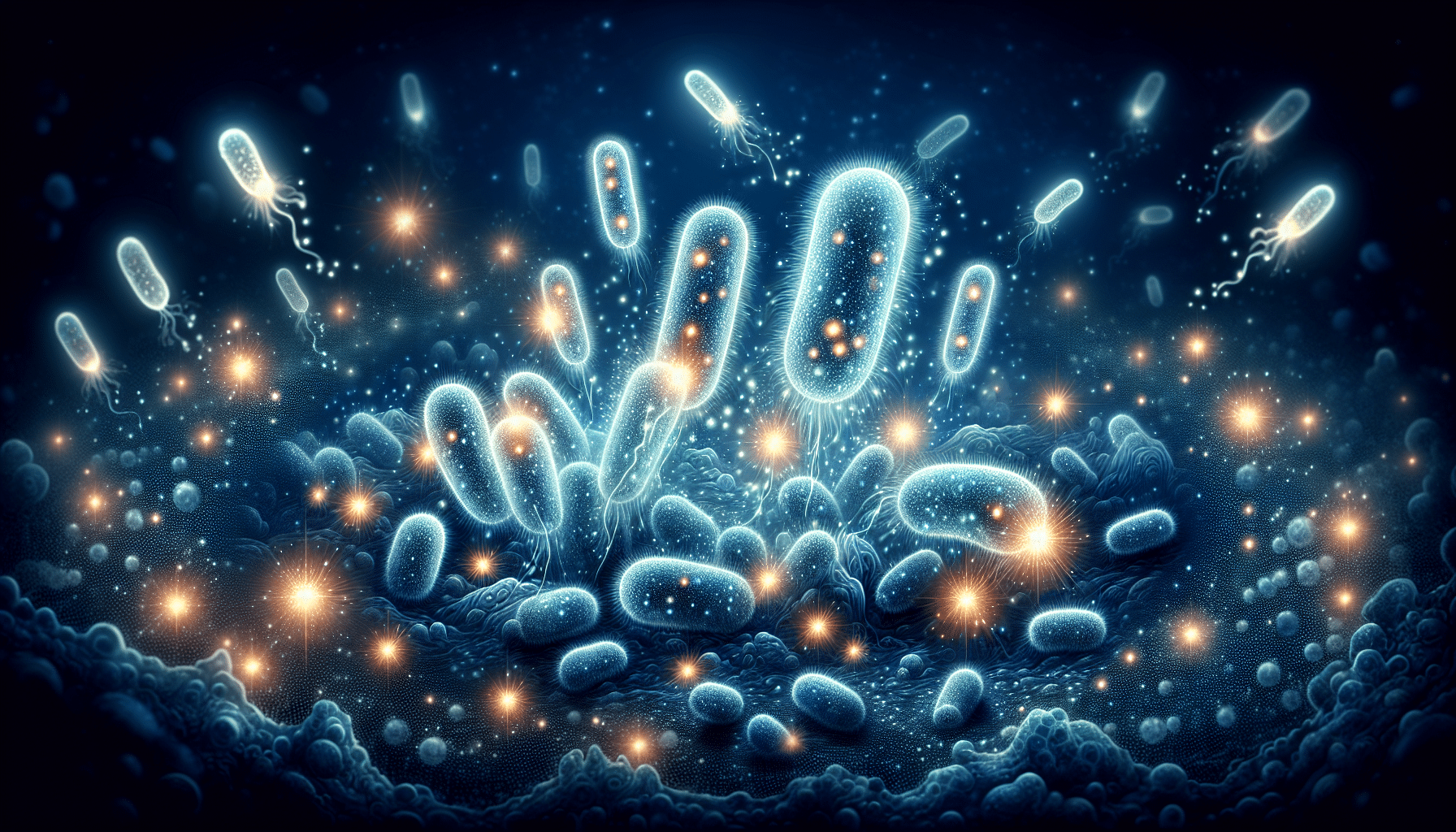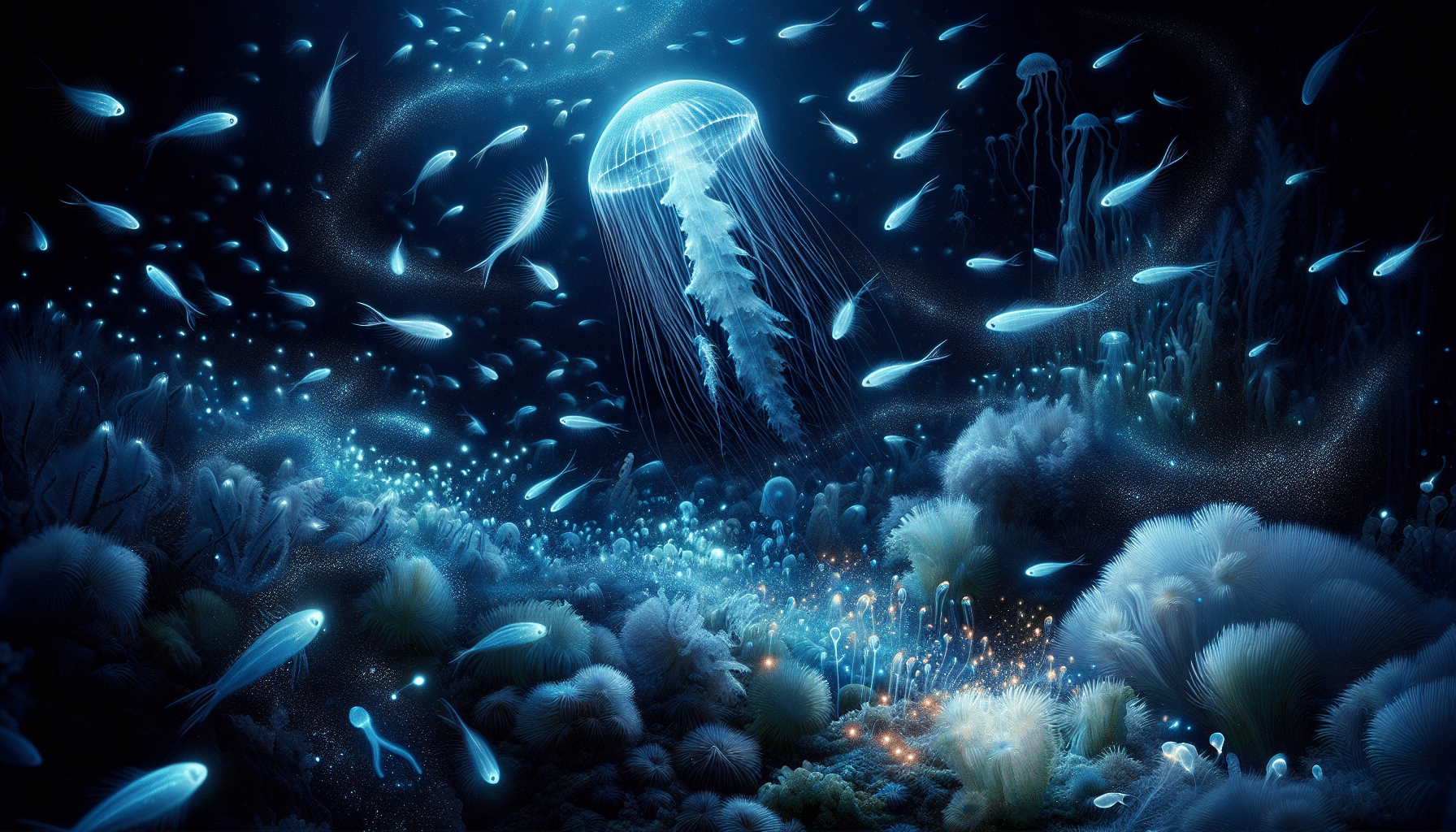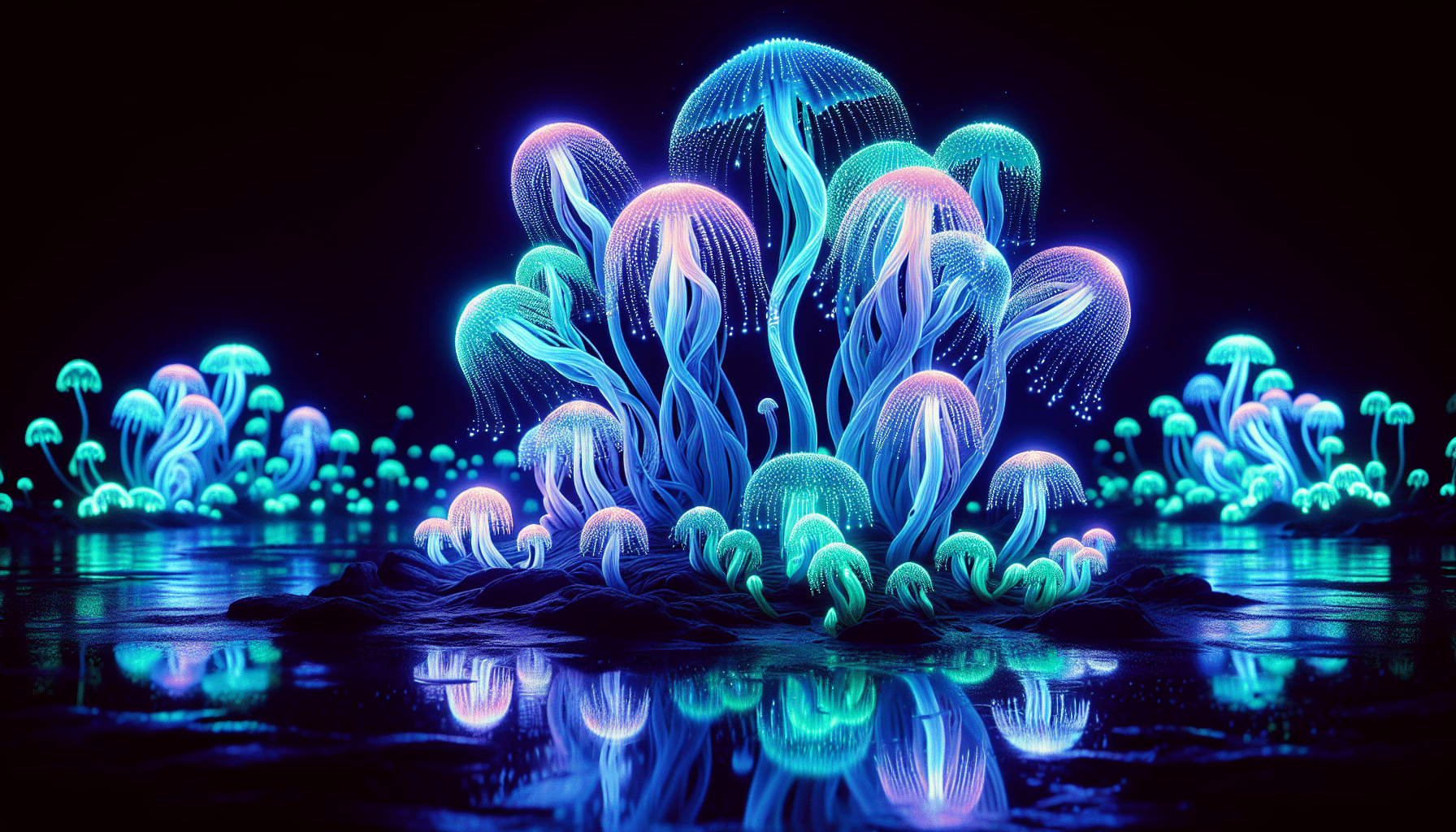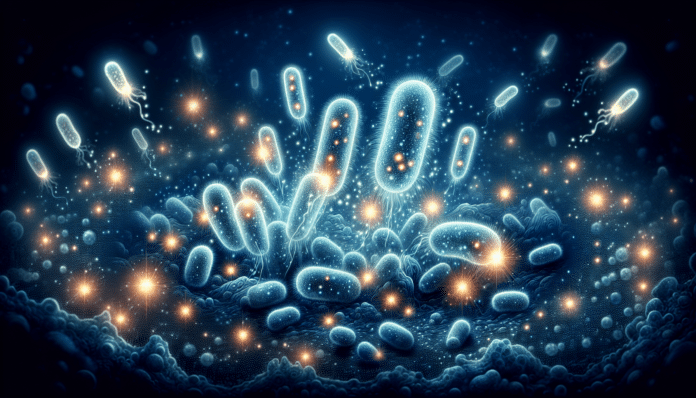Bioluminescence, the ability of living organisms to produce light, is one of nature’s most mesmerizing phenomena. From the deep sea to tropical forests, these living lights captivate and amaze. The wonders of bioluminescence, nature’s living lights, are not only beautiful but also crucial for survival, communication, and scientific discovery. This article delves into the science, diverse ecosystems, and broader significance of bioluminescence.
Key Takeaways
- Bioluminescence is a process where living organisms produce light through a chemical reaction involving luciferin and luciferase, showcasing nature’s adaptability and used for attracting mates, deterring predators, and communication.
- Bioluminescent organisms are found in diverse ecosystems, including marine, terrestrial, and freshwater habitats, each employing unique strategies and functions like defense mechanisms and camouflage.
- Bioluminescence has valuable applications in scientific research, medical diagnostics, environmental monitoring, and innovative fields, such as sustainable lighting and advanced medical imaging.
The Science Behind Bioluminescence

Bioluminescence is the fascinating ability of living organisms to produce and emit light through biochemical reactions. This natural phenomenon, which produces light, is not just a spectacle; it is a testament to nature’s ingenuity and adaptability. At the heart of this process, bioluminescence involves a chemical reaction between a light-emitting molecule called luciferin and an enzyme called luciferase. Luciferin undergoes a chemical reaction with oxygen in the presence of luciferase, resulting in the release of energy in the form of light. This process is known as bioluminescence.
This biochemical marvel is common in many marine organisms, such as the jellyfish Aequorea victoria, and is also found in various terrestrial and freshwater species. The light produced by these organisms can be emitted from within their bodies or ejected into the environment, creating an enchanting glow that serves multiple purposes. The world of bioluminescence is incredibly diverse, with each species exhibiting unique adaptations that allow them to harness this light for survival.
To sum up, the phenomenon of bioluminescence is a result of complex chemical reactions that allow living organisms to emit light. This ability showcases the incredible diversity and adaptability of nature, as different species have evolved to use bioluminescence for various functions, including:
- Attracting mates
- Deterring predators
- Camouflaging in their environment
- Communicating with other members of their species
- Finding food or luring prey
As we delve deeper into the world of bioluminescence, we’ll explore the different ecosystems where these living lights can be found and the roles they play in their respective habitats.
Diverse Ecosystems of Bioluminescent Organisms

Bioluminescent organisms inhabit a range of environments, each offering unique challenges and opportunities for survival. From the vast depths of the ocean to the dense forests on land, these organisms have adapted to their surroundings in remarkable ways. While marine environments are the most common habitats for bioluminescent species, terrestrial and freshwater ecosystems also host their own unique bioluminescent inhabitants.
In the subsequent sections, we will traverse the captivating realm of bioluminescence across diverse ecosystems. We will venture into:
- the mysterious depths of the ocean to unravel the secrets of marine bioluminescence
- the land to encounter glowing fungi and fireflies
- the rare instances of bioluminescence in freshwater environments
Each ecosystem showcases the incredible adaptability and diversity of bioluminescent organisms, revealing the myriad ways nature’s living lights have evolved to thrive in their respective habitats.
Marine Bioluminescence
The deep sea is a realm of perpetual darkness, where bioluminescence becomes the dominant source of light. In these depths, bioluminescent organisms play a crucial role in the survival of many marine species. For instance, Antarctic krill and flashlight fish use their bioluminescence for protection, camouflage, and communication, adapting to the challenges of their lightless environment.
One of the most intriguing examples of marine bioluminescence is the anglerfish, which uses a bioluminescent lure called the esca to attract unsuspecting prey. This glowing bait dangles in front of the anglerfish’s mouth, drawing smaller fish closer and allowing the anglerfish to capture them with ease. Similarly, some species of squid eject sticky bioluminescent mucus to startle and confuse predators, providing a valuable escape mechanism.
Another fascinating adaptation is seen in the hatchetfish, which uses counterillumination to blend in with the faint light from above. By adjusting their bioluminescence to match the ambient light, hatchetfish can effectively camouflage themselves from predators lurking below. Even sea cucumbers have developed a unique defense mechanism, where they can break off luminescent parts of their bodies to distract predators while they make their escape.
These instances underscore the astonishing range and adaptability of marine organisms that possess bioluminescence. Bioluminescence serves a myriad of functions, making it an essential survival tool in the dark ocean depths. Some of these functions include:
- Hunting
- Communication
- Defense
- Camouflage
Terrestrial Bioluminescence

On land, bioluminescence is most famously exhibited by fireflies, whose enchanting light displays are a common sight in many parts of the world. Fireflies use their bioluminescence for mating signals, with males flashing distinctive patterns to attract females. Each species of firefly has a unique flash pattern, allowing individuals to recognize and communicate with potential mates in the dark.
Bioluminescent fungi are another intriguing example of terrestrial bioluminescence. These fungi produce light to attract insects, which then help disperse their spores. This clever adaptation ensures that the fungi can spread their genetic material over a wide area, increasing their chances of survival. Additionally, the only known bioluminescent land snail, Quantula striata, found in Southeast Asia, adds to the diversity of bioluminescent organisms on land.
One of the most unusual terrestrial bioluminescent organisms is the railroad worm. The larvae of this species glow red in their heads and green in their bodies, creating a striking visual display. This bioluminescence likely serves as a warning signal to predators, indicating that the larvae are unpalatable or toxic.
These instances demonstrate how terrestrial bioluminescence is predominantly employed for communication and defense, reflecting nature’s incredible capacity for adaptation.
Freshwater Bioluminescence
Freshwater environments are relatively rare habitats for bioluminescent organisms. Unlike marine and terrestrial ecosystems, freshwater habitats have not been around as long, leading to fewer species that exhibit bioluminescence. The few bioluminescent organisms found in freshwater environments typically rely on other adaptations for survival.
For example, many freshwater species have developed sensitive whiskers or other sensory organs to navigate their environments and detect prey. These adaptations compensate for the lack of bioluminescence, allowing these organisms to thrive in their habitats. The scarcity of bioluminescence in freshwater highlights the unique evolutionary paths taken by different species to adapt to their surroundings.
Functions and Benefits of Bioluminescence

In the natural world, bioluminescence serves a variety of vital functions, contributing to processes such as communication and camouflage. This biological phenomenon is found in organisms ranging from fireflies to deep-sea creatures. For many organisms, producing light is essential for attracting mates and prey, deterring predators, and facilitating communication and coordination. This ability to produce light through biochemical reactions has evolved as a survival mechanism in competitive and dark environments, showcasing the incredible adaptability of bioluminescent organisms.
In the ensuing subsections, we will delve into the particular roles and advantages of bioluminescence with meticulous detail. We’ll examine:
- How certain species use light to attract mates and prey
- The defensive strategies employed by bioluminescent organisms
- The role of bioluminescence in communication and coordination among species.
Attracting Mates and Prey
Fireflies are perhaps the most well-known example of bioluminescent organisms that use light to attract mates. Male fireflies emit distinctive flash patterns to communicate their species and interest in mating, while females respond with their own flashes, allowing the two to find each other in the dark. This light-based communication is crucial for their reproductive success.
The anglerfish, on the other hand, uses bioluminescence to attract prey. It possesses a bioluminescent filament on its head, which acts as a lure to draw smaller fish closer. Once the prey is within reach, the anglerfish swiftly captures it, demonstrating how bioluminescence can be a highly effective hunting strategy. These instances demonstrate the utilization of bioluminescence by various species to lure both mates and prey, underscoring its crucial role in their survival.
Defense Mechanisms
Bioluminescence is also a powerful tool for defense. Some species of squid, for instance, use bioluminescent flashes to startle predators, giving them a chance to escape. Similarly, brittle stars can detach their glowing arms to distract predators while they crawl away, effectively using light as a decoy. These strategies demonstrate the creative ways in which bioluminescent organisms can evade danger.
Certain jellyfish species create flashes of light to confuse predators, allowing them to escape unharmed. The vampire squid, in particular, ejects sticky bioluminescent mucus to disorient and delay predators, providing it with a valuable opportunity to flee. These instances underscore the varied defensive strategies employed by bioluminescent organisms, demonstrating the flexibility and efficacy of bioluminescence as a survival tool.
Communication and Coordination
Bioluminescence is not just for attracting mates and deterring predators; it also plays a crucial role in communication and coordination among species. Antarctic krill, for example, use bioluminescence to stay in touch with each other in the dark ocean, ensuring group coordination and cohesion. This ability to communicate through light is essential for their survival in the vast and often treacherous marine environment.
The Hawaiian bobtail squid offers another fascinating example of bioluminescent symbiosis. This species houses luminescent bacteria in a specialized organ, providing a ‘lantern’ for itself while offering a safe habitat for the bacteria. This mutualistic relationship highlights the intricate ways in which bioluminescence can facilitate communication and cooperation between different organisms.
These instances show the significance of bioluminescence in sustaining social structures and securing the survival of species within their specific environments.
Bioluminescence in Scientific Research

Bioluminescence has emerged as a priceless instrument in scientific research, shedding light on aspects of molecular biology, gene expression, and disease progression. One of the most significant breakthroughs in this field was the discovery of Green Fluorescent Protein (GFP) from the jellyfish Aequorea victoria. GFP emits bright green fluorescence when exposed to blue light, revolutionizing cell biology and biochemistry by allowing scientists to:
- Track cellular processes in real time
- Visualize protein localization and movement within cells
- Study protein-protein interactions
- Monitor gene expression
- Investigate disease progression
This discovery has had a profound impact on our understanding of biological processes and has opened up new avenues for research.
Bioluminescent markers, such as GFP and its enhanced variants, are now widely used in live cell imaging to monitor protein dynamics, interactions, and gene expression. These markers have been instrumental in advancing our understanding of complex biological systems and have paved the way for numerous medical and scientific advancements.
In addition to GFP, bioluminescent imaging techniques are used to study infections, track the spread of diseases, and monitor the effectiveness of treatments in live animals. These non-invasive methods provide real-time insights into the progression of infections and the impact of therapeutic interventions, highlighting the immense potential of bioluminescence in medical research.
The usage of bioluminescence in science is extensive and continues to broaden, presenting novel opportunities for comprehending and battling an array of diseases.
Cultural and Historical Significance of Bioluminescence
For centuries, bioluminescence has enthralled the human imagination, imprinting itself on diverse cultures and historical documents. Ancient civilizations, such as the Romans and Greeks, documented the glow of worms and luminous organisms in water, marveling at these natural wonders. Similarly, Scandinavian and Polynesian folklore is rich with stories of bioluminescent phenomena, often attributing mystical or supernatural significance to these enchanting glows, making them a natural wonder.
The cultural and historical significance of bioluminescence highlights its role in illuminating the hidden and often magical aspects of the natural world. These stories and accounts reflect humanity’s long-standing fascination with bioluminescence, which continues to inspire awe and wonder to this day. By understanding the historical context of bioluminescence, we gain a deeper appreciation for how these living lights have shaped human culture and knowledge.
Modern Applications and Innovations
In the present day, bioluminescence is utilized in a spectrum of innovative applications, including:
- Environmental surveillance
- Breakthroughs in the fields of medicine and agriculture
- Green energy, where scientists are exploring the use of bioluminescent plants for sustainable home lighting and self-illuminating streets
This remarkable efficiency of bioluminescence offers a potential solution for reducing energy consumption and creating eco-friendly lighting options.
Photophores from deep-sea creatures are also being studied for their potential in developing advanced medical imaging techniques, providing clearer and more detailed images for diagnostic purposes. These innovations demonstrate the vast potential of bioluminescence in addressing modern challenges and improving various aspects of our lives.
Environmental Monitoring
Bioluminescent bacteria, like Aliivibrio fischeri, are utilized in environmental surveillance to identify contaminants in water. These bacteria emit light, and any dimming of their glow indicates the presence of harmful chemicals like heavy metals or other toxic substances. This method allows for real-time monitoring of water quality, providing a sensitive and efficient way to identify and measure environmental pollution.
These bioluminescent assays are not only highly sensitive but also offer the advantage of detecting minute concentrations of pollutants, making them an invaluable tool for environmental protection. By utilizing the natural properties of bioluminescent bacteria, scientists can ensure the safety and health of freshwater environments and other ecosystems.
Medical and Agricultural Advances
Thanks to its high detectability and swift response, bioluminescence has brought about a revolution in the realm of medical diagnostics and drug discovery. In clinical research, bioluminescent assays are used to monitor gene expression, study diseases, and screen potential drugs. Fluorescent proteins, such as GFP, are utilized in developing biosensors that can track cellular processes and detect the activity of specific enzymes in tumor cells.
In the field of agriculture, research is being conducted into the use of bioluminescence to enhance crop resistance and optimize resource management. Researchers are working on engineering plants with bioluminescent genes to signal when they need water or nutrients, potentially reducing crop waste and enhancing agricultural productivity. These applications highlight the versatility and impact of bioluminescence in advancing both medical and agricultural fields.
Summary
Bioluminescence is a testament to nature’s brilliance, showcasing the diverse ways in which living organisms produce light to survive and thrive. From the deep sea to dense forests, bioluminescent organisms have adapted to their environments in remarkable ways, using light for attracting mates, luring prey, deterring predators, and communicating with each other. The science behind bioluminescence has also paved the way for significant advancements in research, medicine, and environmental monitoring.
As we continue to explore and harness the potential of bioluminescence, we uncover new applications and innovations that can benefit various aspects of our lives. This journey through the world of bioluminescence not only deepens our understanding of these living lights but also inspires us to appreciate the wonders of nature and the endless possibilities it holds.
Frequently Asked Questions
What is bioluminescence and how does it work?
Bioluminescence is the ability of living organisms to produce and emit light through a chemical reaction involving luciferin and the enzyme luciferase, which releases energy in the form of light.
Where can bioluminescent organisms be found?
Bioluminescent organisms can be found in a variety of ecosystems, including marine environments, forests, and occasionally freshwater environments, with the majority being in the ocean. They play important roles in the deep-sea ecosystem.
What are some examples of bioluminescent organisms and their uses?
Bioluminescent organisms such as fireflies, anglerfish, and certain squids use light for mating signals, attracting prey, and deterring predators.
How is bioluminescence used in scientific research?
Bioluminescence is used in scientific research as a tool in molecular biology to track gene expression, monitor cellular processes, and study infections, revolutionizing cell biology. It provides a way to visualize and study biological processes in real-time.
What modern applications of bioluminescence are being explored?
Modern applications of bioluminescence being explored include environmental monitoring, medical diagnostics, drug discovery, and agricultural innovations, offering promising possibilities for various fields.

